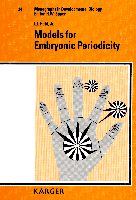
Preface
Lord Kelvin once remarked that he never fully understood a process until he could make a mechanical model of it. This is a book full of models, some of which have profoundly influenced the history of developmental biology. The particular themes of the book, its iconoclastic style, and its focus on cybernetics are attributable to my own academic odyssey. My first exposure to model-building was when I worked as a computer programmer (under Seymour Papert and Marvin Minsky) in the Artificial Intelligence Laboratory at M.I.T., where I was an undergraduate. The lab group was interested in how humans think, and most of the members designed programs to enable computers to "converse", "see", play chess, etc. Others, including myself, wrote interactive programs for teaching children about scientific principles. I created a simulated microworld of reptilian evolution where the user would select an environment, and the reptile population would attempt to adapt by randomly changing the ranges of variation of its anatomical parameters (via "mutations"). What amazed me was how easy it was to reduce seemingly complicated structures (e.g., feathers) to simple equations that could be drawn by graphic algorithms. Only later did I encounter D'Arcy Thompson's "On Growth and Form" which makes this same point for anatomical shapes in general.
Had it not been for an apprenticeship with David Botstein and Ira Herskowitz, where I first encountered the joys (and sorrows) of biological research (my project concerned T7 phage genetics), I might never have left computer science. After applying to and being accepted in the graduate program in U.C. Berkeley's Molecular Biology Department, I was faced with the choice of an advisor and a project. One day, in our core course, John Gerhart delivered a fascinating guest lecture on Escherian symmetries in virus heads, and soon thereafter I asked to work in his lab. At the time, he was investigating both frog and fly development, and I chose to work on flies because of their intriguing patterns of bristles. Chiyo Tokunaga, an expert geneticist, had recently joined the lab after collaborating for many years with Curt Stern, a pioneer in the field of developmental genetics. She would tell me stories of the early days in Stern's lab, when he was formulating his Prepattern Hypothesis. His theory was rapidly being eclipsed by Lewis Wolpert's Positional Information Hypothesis, and it was illuminating to debate the pros and cons of the two paradigms with Chiyo and John. One of the essay questions in John's developmental biology course (co-taught by Gunther Stent) asked about a corollary of Wolpert's "French Flag Problem": how could a concentration gradient of a chemical cause cells to produce blue, white, or red pigments in different zones? My answer was that if cells had vesicles containing pigments of different colors, then the chemical could cause osmotic swelling, and different colors could be released due to different bursting thresholds. I never liked that answer (though I did get an "A" on the test) nor any of the then-popular explanations for how cells interpret positional information. I finished my dissertation in 1977, still skeptical about the ability of the new theory to explain patterns containing large numbers of identical elements such as bristles.
My postdoctoral years were spent in the think tank where the Polar Coordinate Model was born: the Developmental Biology Center at U.C. Irvine. The Center was a cauldron of ideas concocted by the faculty (including my sponsors Peter Bryant and Howard Schneiderman), the postdocs and graduate students, ... and repeatedly stirred and spiced by a parade of visiting scientists. (Cf. the book "Cellular Basis of Morphogenesis" to get a feeling for the ongoing ferment in this field.) To make sense of the panoply of different "patterning" theories, I began classifying them using a framework that I had devised as a graduate student. This book is the culmination of that effort, tempered by years of trying to teach squirming undergraduates about the wonders of gradients and clockfaces. I offer it as a field guide for others who have also felt lost in the wild menagerie of strange models that have lately seemed to multiply without limit.
Constructive comments on the manuscript were kindly furnished by Larry Blanton, Richard Campbell, John Gerhart, Kent Rylander, and Helmut Sauer (series editor). Technical jargon has been avoided wherever possible, but a college-level understanding of embryological principles is essential. Newcomers to developmental biology may find the book's numerous citations useful as entry points to the field's vast literature. Finally, although I have endeavored to achieve an ecumenical scope, my parochial background as a fly researcher colors the text in many places. Do not interpret this slant as bias. The next breakthrough in this field could as easily come from a creature with green leaves as one with six legs.
 SOCIETY FOR DEVELOPMENTAL BIOLOGY
SOCIETY FOR DEVELOPMENTAL BIOLOGY